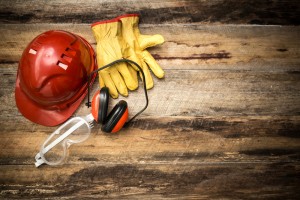Suit Up to Stay Safe – How to Choose the Right Personal Protective Equipment
 You can’t deny that safety clobber isn’t eye-catching – it’s even made it on the fashion runways.
You can’t deny that safety clobber isn’t eye-catching – it’s even made it on the fashion runways.
But joking aside, it’s pretty important to make sure that you make the right choice when you are choosing protective equipment. Did you know that RoSPA estimates around 12,000 employees die each year – after being exposed to harmful working conditions?
Pretty sobering stats. Which just underline why it’s so vital to have the right equipment.
So what do you need to think about before you choose some?
PPE is a last resort
This might sound a bit weird – but personal protective equipment shouldn’t really be the first line of defence when it comes to protecting yourself from hazards and dangers!
As HSE points out, protective equipment only comes into use after you’ve put in place all other safety measures.
After all, there’s very little a protective hard hat or high vis clothing can do – if you haven’t made sure that the machinery or work site is safe in the first place!
Choose the right level of protection
Once you’ve taken care of the major safety issues in your work environment, it’s time to suit up. But before you choose any old protective wear, you really need to think about what you’re protecting against – and what level of protection is needed.
Ask yourself some essential questions –
- What are people going to be exposed to?
- Are different people going to be exposed to different risks?
- How long are they going to be exposed to it?
- And how much of it are they actually going to be exposed to?
The answers to these will help you choose the right kind of equipment needed, by giving you the basic outline of potential hazards.
Are you looking for personal protective equipment (PPE), for example footwear, work gloves, safety equipment, This free quote service by PPE.org can help you save time and money.
Make sure it’s used properly
Once you’ve decided that some protective equipment is essential to protect yourself or others, then it must always be used.
It’s not an “if you fancy it” option. In fact, it’s well worth having a read of the full Personal Protective Equipment at Work Regulations, which explain all the responsibilities on the subject.
But there are a few practical points you should remember too.
For starters, if people are going to be wearing protective clothing – make sure it fits properly! An oversized pair of safety goggles or a helmet that barely fits properly aren’t going to be much use. And neither are people going to be encouraged to use them.
People should also be given proper training on how to use any protective equipment if needed, especially when it is a bit more complex, such as using a respirator.
Don’t underestimate the little things either! It’s important to know how to use and remove protective clothing – especially if they’re likely to be exposed to harmful substances such as asbestos, and need to be properly cleaned before being removed.
Your takeaway points
- PPE is not the first guard against safety hazards – you should always make sure you have the main risks properly met first
- When you choose equipment, ask yourself the essential questions to make sure you make the right picks
- Once you’ve got it – it’s got to be used properly. That means giving training, checking they fit properly, and that everyone knows how to clean and use them!
Do you use personal protective equipment at work? What do you use – and why? Let us know in the comments below!

A chartered (fellow) safety and risk management practitioner with 20+ years of experience. David provides a healthy dose of how-to articles, advice and guidance to make compliance easier for construction professionals, Architects and the built environment. Get social with David on Twitter and Linkedin.




One Comment
Nice post David.
With regards to hand protection, when we engage with companies and conduct initial assessments, it’s amazing to still come across situations where only 1 size of protective glove is being provided to the entire workforce. It just wouldn’t happen if it was footwear!
Gloves which are too large can create folds which can impair work and be uncomfortable whilst gloves that are too small can restrict blood flow and movement which can motivate fatigue.
An ill-fitting piece of PPE can all too easily end up being a hazard in itself!